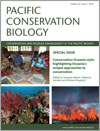
Pacific Conservation Biology
Volume 22 Number 2 2016
Conservation Oceania Style: Highlighting Oceania’s Unique Approaches to Conservation
PCv22n2_EDThinking globally, acting locally – conservation lessons from Oceania
PC15035Empowering citizens to effect change – a case study of zoo-based community conservation
We critically examine a community conservation campaign aimed at increasing uptake of sustainable palm oil (and thus reducing the use of unsustainable palm oil) led by zoos in Australia and New Zealand. We share the elements of success and key learning to build understanding and improvement of these programs globally.
PC15048Biodiversity conservation in Sydney Harbour
Sydney Harbour has significant environmental and conservation value, however, like many other harbours, is subject to stressors. We outline its environmental assets and major threats, and report on current and developing conservation strategies. This knowledge may help coastal and harbour managers within the region to better prepare for similar challenges.
PC15038Conservation Science Statement. The demise of New Zealand's freshwater flora and fauna: a forgotten treasure
New Zealand has some of the highest levels of threatened freshwater species in the world but this is often ignored in favour of managing water quality. To improve this we must change legislation to protect endangered species, and their habitats, include habitat protection in the National Objectives Framework (NOF), establish monitoring of threatened invertebrates, better manage riparian zones and include wetlands, estuaries, and groundwater ecosystems in the NOF.
PC15047Australia's wetlands – learning from the past to manage for the future
We reviewed knowledge about the extent of wetlands, representativeness, impacts and threats to integrity and options for effective conservation. Management and policy for wetlands is dependent on knowledge of distribution, type and extent of wetlands, a key national constraint. Mitigation of increasing development (e.g. northern Australia) will be critical for conservation, along with adequate representation in protected areas, and restoration, particularly with environmental flows.
Deforestation remains a significant threat to Australia’s biodiversity. I provide a detailed critique of the native vegetation policies introduced across Australia over the last 40 years, and quantify deforestation trends from 1972–2014. A more effective policy mix, with a greater focus on monitoring, evaluation and policy learning, is needed to curb deforestation in Australia.
PC15036The context and potential sustainability of traditional terrestrial periodic tambu areas: insights from Manus Island, Papua New Guinea
No-take tambu areas are an indigenous resource management tool found in Melanesia characterised by a cycle of resource closure followed by instantaneous harvest. We review the use of the method to restock areas with Admiralty cuscus and examine the plausibility of population recovery given differing time intervals and harvest rates.
PC15050Limitations of biophysical habitats as biodiversity surrogates in the Hauraki Gulf Marine Park
A habitat classification system identified 46 biophysical habitat types in the Hauraki Gulf Marine Park. Existing marine protection does not include a majority of habitats, and includes on average only 2.28% of demersal fish species’ ranges. Furthermore, habitats were poorly correlated with demersal fish biodiversity.
PC16001Systematic conservation planning within a Fijian customary governance context
PC15040Emerging threats to biosecurity in Australasia: the need for an integrated management strategy
This review explores how more comprehensive biosecurity initiatives might be implemented in the Australasia region through the adoption of robust pre-border and border quarantine practices, the use of emerging technologies to improve border and post-border biosurveillance and monitoring, and the integration of multiple social, economic and ecological objectives into a more holistic management paradigm.
PC15041Approaches to strategic risk analysis and management of invasive plants: lessons learned from managing gamba grass in northern Australia
Invasive species are a major threat in Oceania (and globally), but there is a of lack methods to prioritise limited management funds. This paper reviews risk assessment components and available tools for each component that can be applied in data-limited environments, such as is often the case in Oceania.



